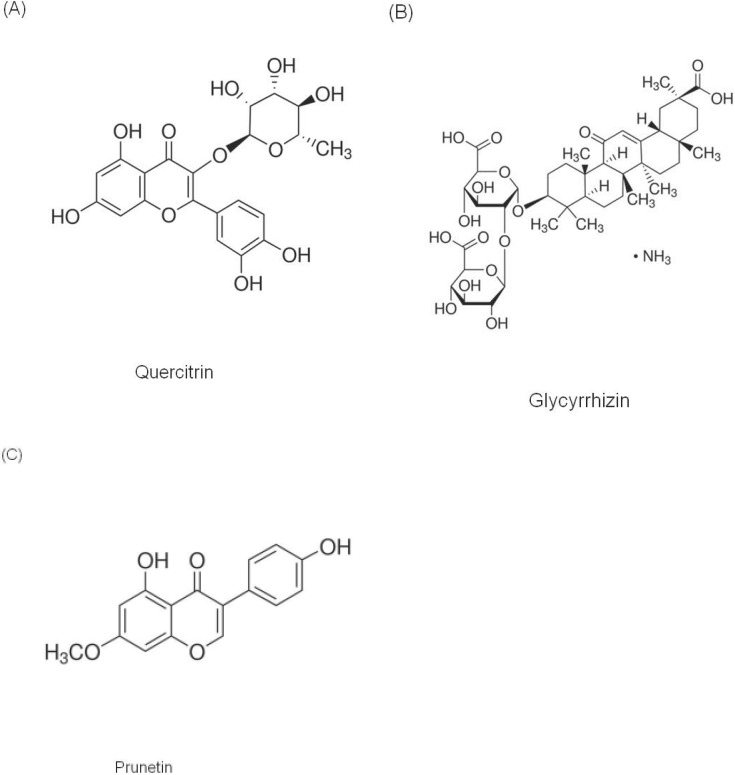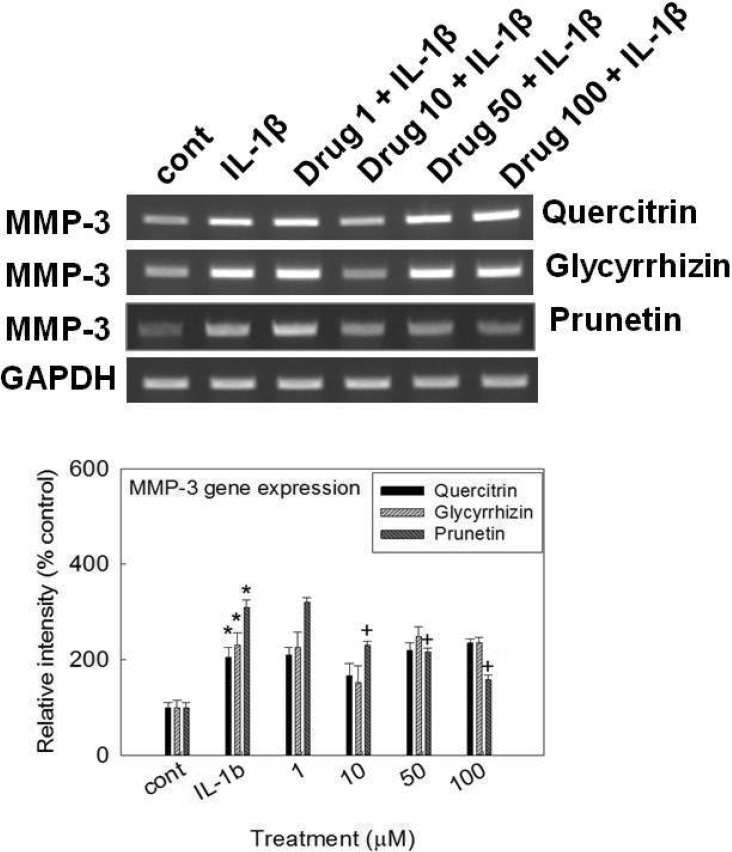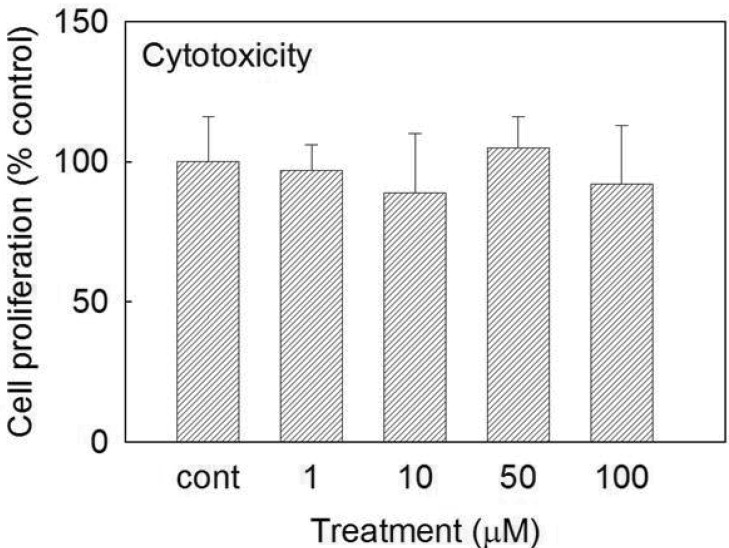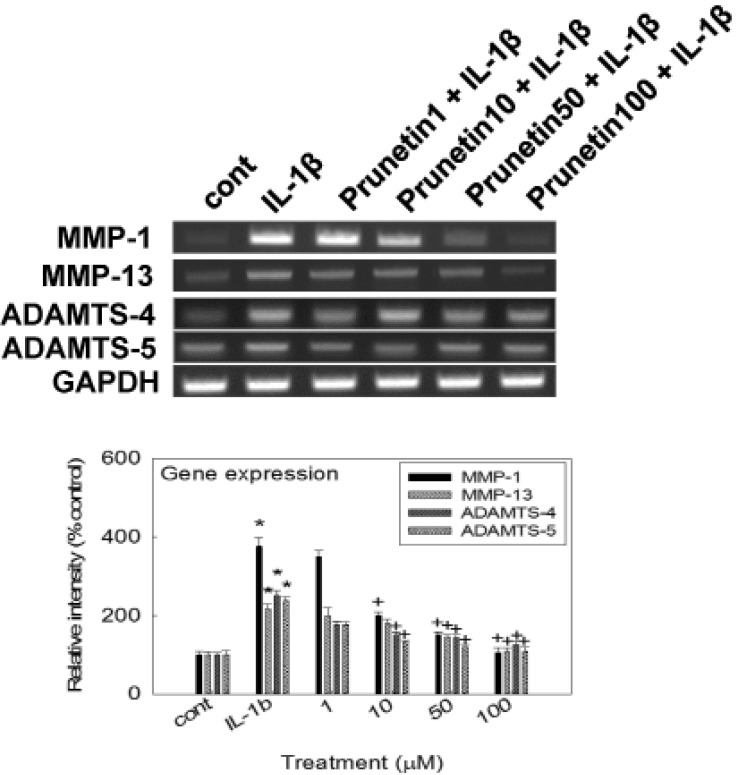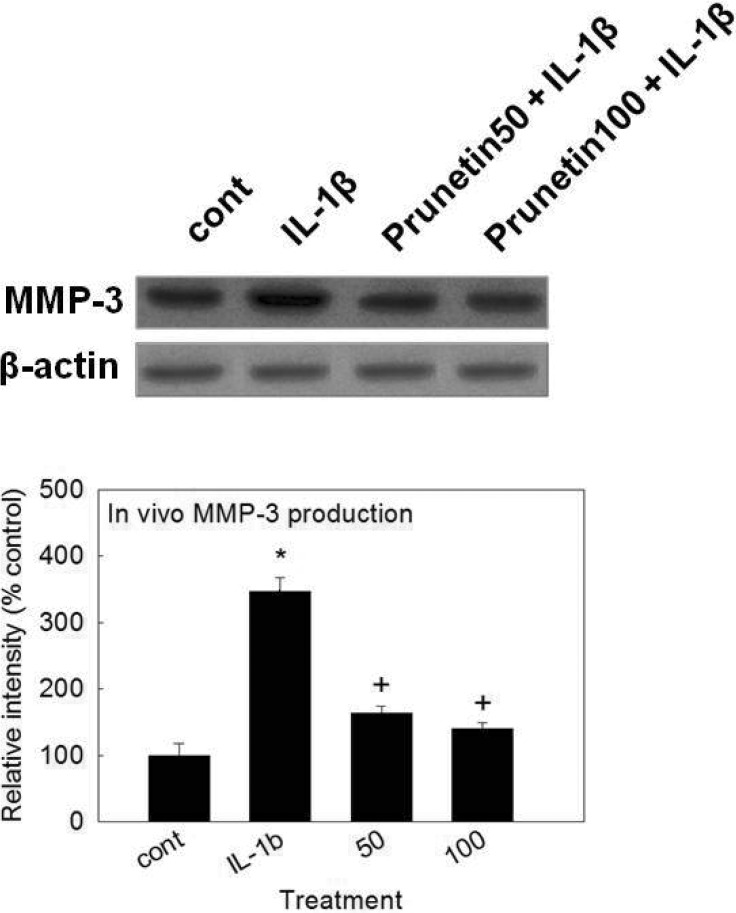Abstract
We investigated whether prunetin affects the proteolytic activity, secretion, and gene expression of matrix metalloproteinase-3 (MMP-3) in primary cultured rabbit articular chondrocytes, as well as in vivo production of MMP-3 in the rat knee joint to evaluate the potential chondroprotective eff ect of prunetin. Rabbit articular chondrocytes were cultured in a monolayer, and reverse transcription-polymerase chain reaction (RT-PCR) was used to measure interleukin-1β (IL-1β)-induced expression of MMP-3, MMP-1, MMP-13, a disintegrin and metalloproteinase with thrombospondin motifs-4 (ADAMTS-4), and ADAMTS-5. In rabbit articular chondrocytes, the effects of prunetin on IL-1β-induced secretion and proteolytic activity of MMP-3 were investigated using western blot analysis and casein zymography, respectively. The eff ect of prunetin on MMP-3 protein production was also examined in vivo. The results were as follows: (1) prunetin inhibited the gene expression of MMP-3, MMP-1, MMP-13, ADAMTS-4, and ADAMTS-5; (2) prunetin inhibited the secretion and proteolytic activity of MMP-3; (3) prunetin suppressed the production of MMP-3 protein in vivo. These results suggest that prunetin can regulate the gene expression, secretion, and proteolytic activity of MMP-3, by directly acting on articular chondrocytes.
Keywords: Chondrocyte, Metalloproteinase, Osteoarthritis, Prunetin
INTRODUCTION
It is reported that osteoarthritis, the most common degenerative articular disease, affects multimillions of people, especially in the elderly. The major pathophysiologic characteristics of osteoarthritis are formation of osteophytes, synovial inflammation, degeneration of articular cartilage, and changes in subchondral bone. The cause of osteoarthritis is still unclear, and involves multiple biochemical and mechanical factors. The equilibrium between physiologic synthesis and degradation of articular cartilage is disrupted during the progression of osteoarthritis [1,2].
In articular cartilage, the activation of degradative enzymes leads to the loss and degradation of proteoglycans and collagen. Particularly, the matrix metalloproteinases (MMP) play a pivotal role in the destruction of articular cartilage in osteoarthritis patients [3,4]. The types of MMP include collagenases (MMP-1, -8 and -13), gelatinases (MMP-2 and -9), and stromelysins (MMP-3, -7, -10 and -11) [5,6]. Among them, MMP-3 degrades proteoglycans and activates procollagenase in articular cartilage [7,8]. Therefore, elucidation of the mechanisms through which the proteolytic activity, secretion, and gene expression of MMP-3 are inhibited by plant-derived natural products used as arthritis remedies in folk medicine will support the effective treatment of osteoarthritis, and may lead to new therapeutic strategies.
According to a number of reports, prunetin, a flavonoidal compound derived from Glycyrrhizae Radix, a medicinal plant used for controlling various inflammatory diseases in folk medicine, showed the biological activities including anti-inflammatory effect [9,10,11,12,13]. Prunetin regulated MUC5AC mucin gene expression and production of mucin glycoprotein through affecting NF-κB signaling pathway [10,11]. Prunetin showed anti-obesity potential [12] and inhibited human liver aldehyde dehydrogenase [13]. However, to the best of our knowledge, there are no report about the effects of prunetin on the gene expression, secretion, and enzyme activity of MMP-3, an articular cartilage-degradative enzyme that decomposes proteoglycans, in primary cultured rabbit articular chondrocytes, or on in vivo production of MMP-3 in the rat knee joint. Therefore, to evaluate the chondroprotective potential of prunetin, we investigated its effects on IL-1β-induced gene expression, secretion, and enzyme activity of MMP-3 in vitro, and on production of MMP-3 in vivo.
METHODS
Materials
All chemicals and reagents used in this experiment, including prunetin (purity: 98.0%), quercitrin (purity: 95.0%) and glycyrrhizin (purity: 95.0%) were purchased from Sigma-Aldrich (St. Louis, MO, USA) unless otherwise specified. Dulbecco's Modified Eagle's Medium (DMEM) was purchased from Gibco-BRL (Grand Island, NY, USA) and recombinant human IL-1β was purchased from R&D Systems (Minneapolis, MN, USA).
Primary cultures of chondrocytes from rabbit articular Cartilage
Male New Zealand White rabbits were obtained from Daehan Biolink (Seoul, South Korea) at 2 weeks of age. Animals were housed 1 animal per cage, provided with distilled water and food ad libitum, and kept under a 12 h light/dark cycle (lights on from 08:00~20:00) at constant temperature (22.5℃) and humidity (55%). Animals were cared for in accordance with the Guide for the Care and Use of Laboratory Animals, and care was regulated by Chungnam National University (the approval number of animal experiment: CNU-00555) (Daejeon, Korea). Rabbit articular chondrocytes were isolated from the tibial plateau and femoral condyle in cartilage of the knee joint. Cartilage was washed in phosphate-buffered saline (PBS) and minced into pieces measuring 2 mm3, approximately. Cartilage tissue was digested for 4 h with 0.2% type II collagenase at 37℃. After collection of individual cells by brief centrifugation, the cells were transferred to 100 mm culture dishes (seeding density: 105 cells/cm2) in 12 mL DMEM supplemented with 10% fetal bovine serum (FBS), in the presence of penicillin (100 units/ mL) and streptomycin (100 µg/mL). Cells were cultured at 37℃ in a humidified, 5% CO2/95% air, water-jacketed incubator, and medium was replaced every other day [14].
Treatment of cells with prunetin and the other natural products
Chondrocytes were seeded on 6-well culture plates at a density of 105 cells/cm2. After 2 days in monolayer culture, the cells were incubated for 2 h in growth medium with 1, 10, 50, or 100 µM of prunetin, glycyrrhizin or quercitrin, followed by incubation in the presence or absence of IL-1β (10 ng/mL) for 24 h. Prunetin, glycyrrhizin or quercitrin was dissolved in dimethylsulfoxide, diluted in PBS, and administered in culture medium (final concentrations of dimethylsulfoxide were 0.5%). The final pH values of these solutions were between 7.0 and 7.4. Culture medium and 0.5% dimethylsulfoxide in medium did not affect the gene expression, secretion, or proteolytic activity of MMP-3 in primary cultured chondrocytes. The supernatant was collected and centrifuged, and cell and supernatant fractions were stored at –80℃ until use.
Cytotoxicity assay
Chondrocytes were seeded at a density of 2×105/mL (0.1 mL / well) in a 96-well microtiter plate, and allowed to attach for 24 h to keep the log phase growth at the time of drug treatment. Prunetin was dissolved in DMSO, and administered in DMEM supplemented with 10% FBS (final concentrations of DMSO were under 0.5%). 0.5% DMSO alone did not affect the proliferation of chondrocytes. After incubation with the indicated drug concentrations for 72 h, cell proliferation was determined using the sulforhodamine B (SRB) assay [15].
Isolation of total RNA and RT-PCR
Total RNA was isolated from chondrocytes using the Easy-BLUE Extraction Kit (INTRON Biotechnology, Inc. Kyungki-do, South Korea), and reverse transcribed using AccuPower RT Premix (BIONEER Corporation, Daejeon, South Korea) according to the manufacturer's instructions. About 2 µg of total RNA was primed with 1 µg of oligo (dT) in a final reaction volume of 30 µL. 2 µL of RT reaction product was amplified in 20 µL using Thermoprime Plus DNA Polymerase (ABgene, Rochester, NY, USA). PCR was performed with the following primers: MMP-3 (5'ATG GAC CTT CTT CAG CAA 3', 5'TCA TTA TGT CAG CCT CTC 3'), MMP-13 (5'AGG AGC ATG GCG ACT TCT AC 3', 5'TAA AAA CAG CTC CGC ATC AA 3'), MMP-1 (5'TCA GTT CGT CCT CAC TCC AG 3', 5'TTG GTC CAC CTG TCA TCT TC 3'), ADAMTS-4 (5'CAA GGT CCC ATG TGC AAC GT 3', 5'CAT CTG CCA CCA CCA GTG TCT 3'), and ADAMTS-5 (5'TGT CCT GCCAGC GGATGT 3'; 5'ACG GAA TTA CTG TAC GGC CTA CA 3'). GAPDH (5'ACT GGC GTC TTC ACC ACC AT 3'; 5'AAG GCC ATG CCA GTG AGC TT 3') was used as a quantitative control. The PCR products increased as the concentration of RNA increased. The amplified fragment sizes were 350 base pairs (bp) for MMP-3, 458 bp for MMP-13, 300 bp for MMP-1, 90 bp for ADAMTS-4, 110 bp for ADAMTS-5, and 400 bp for GAPDH. After PCR, 15 µL of PCR products were subjected to 2% agarose gel electrophoresis and visualized with ethidium bromide under a transilluminator [14].
Western blot analysis for measuring secretion level of MMP-3 in culture supernatant
The Bradford assay was used to measure protein concentrations in culture supernatants to ensure consistent weight of protein samples subjected to electrophoresis. Culture supernatant samples containing MMP-3 protein (50 µg each) were subjected to 10% sodium dodecyl sulfate–polyacrylamide gel electrophoresis (SDS-PAGE), and then transferred onto a polyvinylidene difluoride (PVDF) membrane. Blots were blocked using 5% skim milk in Tris-buffered saline/Tween 20 (TBS-T), and probed overnight with MMP-3 antibody in blocking buffer at 4℃. Antibody against MMP-3 was purchased from Santa Cruz Biotechnology (Santa Cruz, CA, USA). Membranes were washed with TBS-T and probed for 1 h with a secondary antibody conjugated with horseradish peroxidase (Calbiochem, La Jolla, CA, USA). After 4 washes with TBS-T, immunoreactive bands were detected using an enhanced chemiluminescence kit (Pierce ECL western blotting substrate, Thermo Scientific, Waltham, MA, USA).
Casein zymography to measure the proteolytic activity of MMP-3
A modified casein-substrate zymography was carried out using culture supernatants from chondrocytes pretreated for 2 h with prunetin and stimulated for 24 h with IL-1β in DMEM containing 0.5% FBS. The Bradford assay was used to measure protein concentrations in culture media to ensure consistency across samples. Samples were electrophoresed at 4℃ in a 10% SDS gel containing 0.1% casein. After electrophoresis, gels were washed with 10 mM Tris-HCl (pH 8.0) containing 2.5% Triton X-100. Next, gels were incubated at 37℃ for 48 h in 50 mM Tris-HCl (pH 8.0) containing 1% Triton X-100, 0.2 M NaCl, and 5 mM CaCl2. Finally, gels were stained with 1% Coomassie Brilliant Blue, destained, and photographs were taken [14].
In vivo experiments
Male Sprague–Dawley rats (Daehan Biolink, Seoul, South Korea) weighing 200~210 g were used to investigate the effect of prunetin on production of MMP-3 in articular cartilage in vivo. Animals were housed 5 per cage, provided with distilled water and food ad libitum, and kept under a 12 h light/dark cycle (lights on from 08:00~20:00) at constant temperature (22.5℃) and humidity (55%). Animals were cared for in accordance with the Guide for the Care and Use of Laboratory Animals, and care was regulated by Chungnam National University (the approval number of animal experiment: CNU-00555) (Daejeon, South Korea). Rats were randomly divided into 4 groups: control, IL-1β only, 50 µM prunetin plus IL-1β, or 100 µM prunetin plus IL-1β. Rats were anesthetized with vaporized diethyl ether, and those from the 50 µM prunetin plus IL-1β and 100 µM prunetin plus IL-1β treatment groups received a 30 µL injection of 50 µM or 100 µM prunetin, respectively, into the right knee joint. After 3 h, rats from the IL-1β only group, the 50 µM prunetin plus IL-1β group, and the 100 µM prunetin plus IL-1β group received a 30 µL injection of 20 ng IL-1β in sterile PBS into the right knee joint. Rats from the control group were injected with 30 µL of sterile PBS. Rats were euthanized via CO2 asphyxiation 72 h after injections. Articular cartilage (tibial plateau and femoral condyle) was isolated from each animal, homogenized, and prepared for measurement of MMP-3 protein by western blot analysis. Tissue lysates from articular cartilage homogenates containing MMP-3 protein (50 µg each) were subjected to 10% SDS-PAGE, and transferred onto a PVDF membrane. Blots were blocked with 5% skim milk in TBS-T, and probed with MMP-3 antibody (Santa Cruz Biotechnology, Santa Cruz, CA, USA) in blocking buffer overnight at 4℃. Membranes were washed with TBS-T, and probed for 1 h with a secondary antibody conjugated with horseradish peroxidase (Calbiochem, La Jolla, CA, USA). After 4 washes with TBS-T, immunoreactive bands were detected using an enhanced chemiluminescence kit (Pierce ECL western blotting substrate, Thermo Scientific, Waltham, MA, USA).
Statistics
Means of individual group were converted to percent control and expressed as mean±S.E.M. The difference between groups was assessed using one-way ANOVA and Holm-Sidak test as a post-hoc test. p<0.05 was considered as significantly different.
RESULTS
Effect of prunetin, glycyrrhizin or quercitrin on MMP-3 gene expression in rabbit chondrocytes
To compare the potency of activity on the gene expression of MMP-3, the key matrix metalloproteinase involved in destruction of articular cartilage, effect on MMP-3 gene expression was investigated by pretreatment of glycyrrhizin or quercitrin – major steroidal compound derived from Glycyrrhizae Radix or similar flavonoidal compounds with prunetin – in addition to prunetin (Fig. 1). As shown in Fig. 2, prunetin inhibited IL-1β-induced MMP-3 gene expression, at 10 µM, 50 µM, and 100 µM. However, glycyrrhizin or quercitrin did not significantly affect MMP-3 gene expression.
Fig. 1. Chemical structure of glycyrrhizin, quercitrin and prunetin.
Fig. 2. Effect of glycyrrhizin, quercitrin or prunetin on MMP-3 gene expression in rabbit chondrocytes.
Primary cultured rabbit articular chondrocytes were pretreated with varying concentrations (1, 10, 50, and 100 µM) of glycyrrhizin, quercitrin or prunetin for 2 h and then stimulated with IL-1β (10 ng/mL) for 24 h. MMP-3 gene expression level was measured by RT-PCR. Three independent experiments were performed and the representative data were shown. The signal intensity of each band was analyzed by GelQuant software (DNR Bio-Imaging Systems Ltd., Jerusalem, Israel). Each bar represents a mean±S. E.M. of three independent experiments in comparison with that of the control set at 100%. *significantly different from control (p<0.05), +significantly different from IL-1β alone (p<0.05) (cont: control, concentration unit is µM).
Effect of prunetin on proliferation of rabbit chondrocytes
To investigate the potential cytotoxicity of prunetin to cultured rabbit chondrocytes, effect of prunetin on proliferation of rabbit chondrocytes using SRB assay was tested. As can be seen in Fig. 3, prunetin showed no significant cytotoxicity at the concentrations of 1, 10, 50, and 100 µM. The numbers of cells in prunetin-treated cultures were 100±16%, 97±9%, 89±21%, 105±11%, and 92±21% for control, 1, 10, 50, and 100 µM prunetin, respectively.
Fig. 3. Effect of prunetin on proliferation of rabbit chondrocytes.
Chondrocytes were incubated for 72 h in the presence of varying concentrations of prunetin. Cell viability was determined using SRB assay as described in Materials and Methods. Each bar represents a mean±S.E.M. of three independent experiments in comparison with that of the control set at 100%.
Effect of prunetin on the gene expression of MMP-1, MMP-13, ADAMTS-4, or ADAMTS-5 in rabbit chondrocytes
If prunetin can affect the gene expression of MMP-3, the key matrix metalloproteinase involved in destruction of articular cartilage, it should be investigated whether prunetin affects the gene expression of MMP-1, MMP-13, ADAMTS-4 or ADAMTS-5, the other degradative enzymes related to destruction of articular cartilage, in rabbit chondrocytes. As shown in Fig. 4, prunetin showed the suppression of IL-1β-induced gene expression of MMP-1, MMP-13, ADAMTS-4, and ADAMTS-5.
Fig. 4. Effect of prunetin on the gene expression of MMP-1, MMP-13, ADAMTS-4, or ADAMTS-5 in rabbit chondrocytes.
Primary cultured rabbit articular chondrocytes were pretreated with varying concentrations (1, 10, 50, and 100 µ M) of prunetin for 2 h and then stimulated with IL-1β (10 ng/mL) for 24 h. The gene expression level of MMP-1, MMP-13, ADAMTS-4, or ADAMTS-5 was measured by RT-PCR. Three independent experiments were performed and the representative data were shown. The signal intensity of each band was analyzed by GelQuant software (DNR Bio-Imaging Systems Ltd., Jerusalem, Israel). Each bar represents a mean±S.E.M. of three independent experiments in comparison with that of the control set at 100%. *significantly different from control (p<0.05), +significantly different from IL-1β alone (p<0.05) (cont: control, concentration unit is µM).
Effect of prunetin on IL-1β-induced secretion of MMP-3 from rabbit articular chondrocytes
If prunetin can affect the MMP-3 gene expression at the transcriptional level, it should be investigated whether prunetin affects IL-1β-induced secretion of MMP-3 proteins from rabbit articular chondrocytes. As shown in Fig. 5, stimulation with IL-1β (10 ng/mL) increased secretion of MMP-3 from chondrocytes. However, prunetin inhibited the effects of IL-1β on MMP-3 secretion. This result means that prunetin can control the steps of protein synthesis and secretion of MMP-3.
Fig. 5. Effects of prunetin on IL-1β-induced secretion of MMP-3 and caseinolytic activity of MMP-3 in rabbit articular chondrocytes.

Primary cultured rabbit articular chondrocytes were pretreated with varying concentrations (1, 10, 50, and 100 µM) of prunetin for 2 h and then stimulated with IL-1β (10 ng/mL) for 24 h. Culture supernatants were collected for measurement of both the levels of produced and secreted MMP-3 by western blot analysis and the proteolytic activity of MMP-3 by casein zymography. Three independent experiments were performed and the representative data were shown. The signal intensity of each band was analyzed by GelQuant software (DNR Bio-Imaging Systems Ltd., Jerusalem, Israel). Each bar represents a mean±S. E.M. of three independent experiments in comparison with that of the control set at 100%. *significantly different from control (p<0.05), +significantly different from IL-1β alone (p<0.05) (cont: control, concentration unit is µM).
Effect of prunetin on proteolytic activity of MMP-3 in rabbit articular chondrocytes
To investigate the effect of prunetin on the enzyme activity of secreted MMP-3, which is known to degrade proteoglycans, one of the two major matrix components of cartilage, culture supernatants from rabbit articular chondrocytes were analyzed for caseinolytic activity by casein zymography, after treatment with IL-1β for 24 h. As can be seen in Fig. 5, IL-1β increased the caseinolytic activity of MMP-3 in rabbit articular chondrocytes, and this effect was inhibited by pretreatment with prunetin.
Effect of prunetin on MMP-3 production in vivo
To investigate whether prunetin shows the potential effect in vivo , we examined the effect of intraarticular injection of prunetin into the knee joint of rats on IL-1β-stimulated production of MMP-3 from articular cartilage tissues. As shown in Fig. 6, treatment with IL-1β (20 ng/30 µL) increased MMP-3 production in articular cartilage tissues. However, prunetin inhibited IL-1β-induced MMP-3 production, in vivo.
Fig. 6. Effect of prunetin on production of MMP-3 in vivo.
The knee joint of rats were pretreated with 50 or 100 µM of prunetin for 3 h and then stimulated with IL-1β (20 ng/30 µL) for 72 h, by intraarticular injection. Tissue lysates from articular cartilage homogenates containing MMP-3 proteins were collected for measurement of the level of produced MMP-3 in vivo, by western blot analysis. The representative data were shown. Equal protein loading was evaluated by β-actin levels. The signal intensity of each band was analyzed by GelQuant software (DNR Bio-Imaging Systems Ltd., Jerusalem, Israel). Each bar represents a mean±S.E.M. of three independent experiments in comparison with that of the control set at 100%. *significantly different from control (p<0.05), +significantly different from IL-1β alone (p<0.05) (cont: control, concentration unit is µM).
DISCUSSION
In order to restore the broken equilibrium between physiological synthesis and degradation of articular cartilage during the progression of osteoarthritis, discovering a useful and specific pharmacological tool can be a promising approach to the effective control of this condition.
Prunetin is a medicinal plant-derived flavonoid that has shown anti-inflammatory and some other biological effects [9,10,11,12,13]. However, to the best of our knowledge, there has been no report on the effects of prunetin on the gene expression, secretion, and enzyme activity of MMP-3, which is an articular cartilage-degradative enzyme that decomposes proteoglycans. Therefore, we examined the effects of prunetin on MMP-3 gene expression, secretion, and proteolytic activty in primary cultured rabbit articular chondrocytes, as well as on MMP-3 production in the rat knee joint.
Although osteoarthritis can be defined as a non-inflammatory disease, its development and progression have been attributed to low-grade inflammation in intraarticular sites, as well as to various inflammatory cytokines in articular tissues and fluids that are produced by chondrocytes and/or interact with chondrocytes [16,17,18,19]. IL-1β is an inflammatory cytokine that is produced by cells in articular tissues, including chondrocytes, and which can increase expression of MMPs and stimulate the progression of osteoarthritis. IL-1β plays an important role in the initiation and progression of destruction of articular cartilage by suppressing synthesis of collagen and stimulating MMP expression [18,20,21]. Particularly, MMP-3 has been reported to play a pivotal pathophysiological role in osteoarthritis by degrading components of the extracellular matrix, such as proteoglycans. MMP-3 levels were increased more than MMP-1 levels in patients suffering from osteoarthritis in knee joints compared to the control group [7,22].
As can be seen in Results, we found that prunetin inhibited IL-1β-induced MMP-3 gene expression (Fig. 2). However, glycyrrhizin or quercitrin – major steroidal compound derived from Glycyrrhizae Radix or similar flavonoidal compounds with prunetin – did not affect MMP-3 gene expression (Figs. 1, 2). This result suggests that prunetin suppresses the gene expression of MMP-3 at the transcriptional level.
In addition to MMP-3, MMP-1 and MMP-13 were reported to play important roles in the destruction of cartilage in osteoarthritis. MMP-1 is a commonly detected metalloproteinase in synovial fluid from patients suffering from osteoarthritis [23,24,25,26,27,28,29]. Another degradative enzyme, ADAMTS-4, is a major aggrecanase in cartilage of mouse and ADAMTS-5 has been known to be important in cartilage matrix destruction during osteoarthritis [30,31].
Therefore, we investigated the effect of prunetin on the gene expression of MMP-1, MMP-13, ADAMTS-4, or ADAMTS-5. As shown in Fig. 4, prunetin inhibited IL-1β-induced gene expression of MMP-1, MMP-13, ADAMTS-4, and ADAMTS-5, in rabbit chondrocytes. Thus, the chondroprotective effects of prunetin are supported by its regulation of the gene expression of diverse proteases involved in the destruction of articular cartilage in osteoarthritis.
Next, if prunetin can affect the MMP-3 gene expression at the transcriptional level, it should be investigated whether prunetin affects IL-1β-induced secretion of MMP-3 proteins from rabbit articular chondrocytes. As shown in Fig. 5, stimulation with IL-1β increased the secretion of MMP-3 from chondrocytes, and this effect was suppressed by prunetin. This result shows that prunetin can regulate the step of protein synthesis and secretion of MMP-3.
To investigate the effect of prunetin on the proteolytic activity of secreted MMP-3, culture supernatants from rabbit articular chondrocytes stimulated with IL-1β for 24 h were analyzed for caseinolytic activity by casein zymography. As can be seen in Fig. 5, the proteolytic activity of MMP-3 was increased when rabbit articular chondrocytes were stimulated with IL-1β. This effect was suppressed by pretreatment with prunetin. This result suggests that prunetin can also affect the proteolytic activity of overproduced and oversecreted MMP-3 in tissues of osteoarthritic articular cartilage.
Lastly, we investigated the effect of intraarticular injection of prunetin into the knee joint of rats on IL-1β-stimulated production of MMP-3 in articular cartilage tissue. As can be seen in Fig. 6, prunetin inhibited IL-1β-stimulated production of MMP-3 in articular cartilage tissue. This result shows that, in addition to its in vitro effects, prunetin exerts chondroprotective effects in vivo when administered via intraarticular injection.
In summary, these results show that the chondroprotective effects of prunetin are produced by its regulation of the gene expression, secretion, and enzyme activity of MMP-3 in articular chondrocytes. Future studies will develop prunetin as a novel agent for the control of cartilage damage in osteoarthritis via intraarticular administration.
Footnotes
CONFLICTS OF INTEREST: The authors have no conflicts of interest to declare.
Author contributions: D.C.N. and B.K.K. performed in vitro and in vivo experiments. H.J.L. and H.D.S. wrote the manu script. C.J.L. and S.C.H. supervised and coordinated the study.
References
- 1.Aigner T, Mckenna L. Molecular pathology and pathobiology of osteoarthritic cartilage. Cell Mol Life Sci. 2002;59:5–18. doi: 10.1007/s00018-002-8400-3. [DOI] [PMC free article] [PubMed] [Google Scholar]
- 2.Mankin HJ. The response of articular cartilage to mechanical injury. J Bone Joint Surg Am. 1982;64:460–466. [PubMed] [Google Scholar]
- 3.Dean D, Martel-pelletier J, Pelletier JP, Howell DS, Woessner JFJ. Evidence for metalloproteinase and metalloproteinase inhibitor imbalance in human osteoarthritic cartilage. J Clin Invest. 1989;84:678–685. doi: 10.1172/JCI114215. [DOI] [PMC free article] [PubMed] [Google Scholar]
- 4.Kullich W, Fagerer N, Schwann H. Effect of the NSAID nimesulide on the radical scavenger glutathione S-transferase in patients with osteoarthritis of the knee. Curr Med Res Opin. 2007;23:1981–1986. doi: 10.1185/030079907X223486. [DOI] [PubMed] [Google Scholar]
- 5.Birkedal-hansen H, Moore WG, Bodden MK, et al. Matrix metalloproteinases: a review. Crit Rev Oral Biol Med. 1993;4:197–250. doi: 10.1177/10454411930040020401. [DOI] [PubMed] [Google Scholar]
- 6.Burrage P, Mix KS, Brinckerhoff CE. Matrix metal-loproteinases: role in arthritis. Front Biosci. 2006;11:529–543. doi: 10.2741/1817. [DOI] [PubMed] [Google Scholar]
- 7.Garnero P, Rousseau JC, Delmas PD. Molecular basis and clinical use of biochemical markers of bone, cartilage, and synovium in joint diseases. Arthritis Rheum. 2000;43:953–968. doi: 10.1002/1529-0131(200005)43:5<953::AID-ANR1>3.0.CO;2-Q. [DOI] [PubMed] [Google Scholar]
- 8.Lin P, Chen CT, Torzilli PA. Increased stromelysin-1 (MMP-3), proteoglycan degradation (3B3- and 7D4) and collagen damage in cyclically load-injured articular cartilage. Osteoarthritis Cartilage. 2004;12:485–496. doi: 10.1016/j.joca.2004.02.012. [DOI] [PubMed] [Google Scholar]
- 9.Yang G, Ham I, Choi HY. Anti-inflammatory effect of prunetin via the suppression of NF-κB pathway. Food Chem Toxicol. 2013;58:124–132. doi: 10.1016/j.fct.2013.03.039. [DOI] [PubMed] [Google Scholar]
- 10.Lee HJ, Lee SY, Lee MN, Kim JH, Chang GT, Seok JH, Lee CJ. Inhibition of secretion, production and gene expression of mucin from cultured airway epithelial cells by prunetin. Phytother Res. 2011;25:1196–1200. doi: 10.1002/ptr.3362. [DOI] [PubMed] [Google Scholar]
- 11.Ryu J, Lee HJ, Park SH, Sikder MA, Kim JO, Hong JH, Seok JH, Lee CJ. Effect of prunetin on TNF-α-induced MUC5AC mucin gene expression, production, degradation of IκB and translocation of NF-κB p65 in human airway epithelial cells. Tuberc Respir Dis. 2013;75:205–209. doi: 10.4046/trd.2013.75.5.205. [DOI] [PMC free article] [PubMed] [Google Scholar]
- 12.Ahn TG, Yang G, Lee HM, Kim MD, Choi HY, Park KS, Lee SD, Kook YB, An HJ. Molecular mechanisms underlying the anti-obesity potential of prunetin, an O-methylated isoflavone. Biochem Pharmacol. 2013;85:1525–1533. doi: 10.1016/j.bcp.2013.02.020. [DOI] [PubMed] [Google Scholar]
- 13.Sheikh S, Weiner H. Allosteric inhibition of human liver aldehyde dehydrogenase by the isoflavone prunetin. Biochem Pharmacol. 1997;53:471–478. doi: 10.1016/s0006-2952(96)00837-4. [DOI] [PubMed] [Google Scholar]
- 14.Moon PD, Jeong HS, Chun CS, Kim HM. Baekjeolyusin-tang and its active component berberine block the release of collagen and proteoglycan from IL-1β-stimulated rabbit cartilage and down-regulate matrix metalloproteinases in rabbit chondrocytes. Phytother Res. 2011;25:844–850. doi: 10.1002/ptr.3353. [DOI] [PubMed] [Google Scholar]
- 15.Skehan P1, Storeng R, Scudiero D, Monks A, McMahon J, Vistica D, Warren JT, Bokesch H, Kenney S, Boyd MR. New colorimetric cytotoxicity assay for anticancer-drug screening. J Natl Cancer Inst. 1990;82:1107–1112. doi: 10.1093/jnci/82.13.1107. [DOI] [PubMed] [Google Scholar]
- 16.Bonnet C, Walsh DA. Osteoarthritis, angiogenesis and inflammation. Rheumatology (Oxford) 2005;44:7–16. doi: 10.1093/rheumatology/keh344. [DOI] [PubMed] [Google Scholar]
- 17.Goldring MB, Otero M, Tsuchimochi K, Ijiri K, Li Y. Defining the roles of inflammatory and anabolic cytokines in cartilage metabolism. Ann Rheum Dis. 2008;67(Suppl 3):iii75–iii82. doi: 10.1136/ard.2008.098764. [DOI] [PMC free article] [PubMed] [Google Scholar]
- 18.Kobayashi M, Squires GR, Mousa A, Tanzer M, Zukor DJ, Antoniou J, Feige U, Poole AR. Role of interleukin-1 and tumor necrosis factor alpha in matrix degradation of human osteoarthritic cartilage. Arthritis Rheum. 2005;52:128–135. doi: 10.1002/art.20776. [DOI] [PubMed] [Google Scholar]
- 19.Loeser RF. Molecular mechanisms of cartilage destruction: mechanics, inflammatory mediators, and aging collide. Arthritis Rheum. 2006;54:1357–1360. doi: 10.1002/art.21813. [DOI] [PMC free article] [PubMed] [Google Scholar]
- 20.Aida Y, Maeno M, Suzuki N, Shiratsuchi H, Motohashi M, Matsumura H. The effect of IL-1beta on the expression of matrix metalloproteinases and tissue inhibitors of matrix metalloproteinases in human chondrocytes. Life Sci. 2005;77:3210–3221. doi: 10.1016/j.lfs.2005.05.052. [DOI] [PubMed] [Google Scholar]
- 21.Pantsulaia I, Kalichman L, Kobyliansky E. Association between radiographic hand osteoarthritis and RANKL, OPG and inflammatory markers. Osteoarthritis Cartilage. 2010;18:1448–1453. doi: 10.1016/j.joca.2010.06.009. [DOI] [PubMed] [Google Scholar]
- 22.Lijnen HR. Matrix metalloproteinases and cellular fibrinolytic activity. Biochemistry Mosc. 2002;67:92–98. doi: 10.1023/a:1013908332232. [DOI] [PubMed] [Google Scholar]
- 23.Freemont AJ, Hampson V, Tilman R, Goupille P, Taiwo Y, Hoyland JA. Gene expression of matrix metalloproteinases 1, 3, and 9 by chondrocytes in osteoarthritic human knee articular cartilage is zone and grade specific. Ann Rheum Dis. 1997;56:542–549. doi: 10.1136/ard.56.9.542. [DOI] [PMC free article] [PubMed] [Google Scholar]
- 24.Goupille P, Jayson MI, Valat JP, Freemont AJ. Matrix metalloproteinases: the clue to intervertebral disc degeneration? Spine (Phila Pa 1976) 1998;23:1612–1626. doi: 10.1097/00007632-199807150-00021. [DOI] [PubMed] [Google Scholar]
- 25.Kanyama M, Kuboki T, Kojima S, Fujisawa T, Hattori T, Takigawa M, Yamashita A. Matrix metalloproteinases and tissue inhibitors of metalloproteinases in synovial fluids of patients with temporomandibular joint osteoarthritis. J Orofac Pain. 2000;14:20–30. [PubMed] [Google Scholar]
- 26.Jo H, Park JS, Kim EM, Jung MY, Lee SH, Seong SC, Park SC, Kim HJ, Lee MC. The in vitro effects of dehydroepiandrosterone on human osteoarthritic chondrocytes. Osteoarthritis Cartilage. 2003;11:585–594. doi: 10.1016/s1063-4584(03)00094-3. [DOI] [PubMed] [Google Scholar]
- 27.Little CB, Barai A, Burkhardt D, Smith SM, Fosang AJ, Werb Z, Shah M, Thompson EW, Little C, Barai A, Burkhardt D, et al. Matrix metalloproteinase 13-deficient mice are resistant to osteoarthritic cartilage erosion but not chondrocyte hypertrophy or osteophyte development. Arthritis Rheum. 2009;60:3723–3733. doi: 10.1002/art.25002. [DOI] [PMC free article] [PubMed] [Google Scholar]
- 28.Neuhold LA, Killar L, Zhao W, Sung ML, Warner L, Kulik J, Turner J, Wu W, Billinghurst C, Meijers T, Poole AR, Babij P, DeGennaro LJ. Postnatal expression in hyaline cartilage of constitutively active human collagenase-3 (MMP-13) induces osteoarthritis in mice. J Clin Invest. 2001;107:35–44. doi: 10.1172/JCI10564. [DOI] [PMC free article] [PubMed] [Google Scholar]
- 29.Yoshihara Y, Nakamura H, Obata K, Yamada H, Hayakawa T, Fujikawa K, Okada Y. Matrix metalloproteinases and tissue inhibitors of metalloproteinases in synovial fluids from patients with rheumatoid arthritis or osteoarthritis. Ann Rheum Dis. 2000;59:455–461. doi: 10.1136/ard.59.6.455. [DOI] [PMC free article] [PubMed] [Google Scholar]
- 30.Echtermeyer F, Bertrand J, Dreier R, Meinecke I, Neugebauer K, Fuerst M, Lee YJ, Song YW, Herzog C, Theilmeier G, Pap T. Syndecan-4 regulates ADAMTS-5 activation and cartilage breakdown in osteoarthritis. Nat Med. 2009;15:1072–1076. doi: 10.1038/nm.1998. [DOI] [PubMed] [Google Scholar]
- 31.Stanton H, Rogerson FM, East CJ, Golub SB, Lawlor KE, Meeker CT, Little CB, Last K, Farmer PJ, Campbell IK, Fourie AM, Fosang AJ. ADAMTS5 is the major aggrecanase in mouse cartilage in vivo and in vitro. Nature. 2005;434:648–652. doi: 10.1038/nature03417. [DOI] [PubMed] [Google Scholar]



